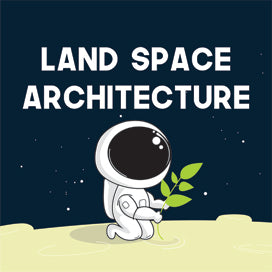Top 10 Landscape Architecture Books Every Designer Should Read
Whether you're a student, a professional, or someone passionate about the design of outdoor spaces, having the right resources can fuel your creativity and expand your design thinking. This curated list of Top 10 Landscape Architecture Books is packed with essential knowledge, stunning visuals, and innovative ideas that have shaped—and continue to shape—the world of landscape design.
From foundational texts to forward-thinking climate resilience guides, these books are must-reads for anyone serious about landscape architecture.

1. Landscape Graphics by Grant W. Reid
A foundational classic, this book covers core principles of environmental planning, urban design, and ecological systems. It’s widely regarded as a bible for landscape architecture students and professionals alike.
Why Read It?
It offers practical guidelines, case studies, and conceptual diagrams that make complex planning accessible and engaging.
Perfect For:
Students and early-career designers working on their portfolio or studio presentations.

2. Landscape Ecology Principles in Landscape Architecture and Land-Use Planning by Wenche E. Dramstad, James D. Olson, and Richard T.T. Forman
This concise handbook presents and explains principles of landscape ecology, offering specific examples of how these principles can be applied in a range of landscape architecture and land-use planning contexts.
Why Read It?
It bridges the gap between ecological science and practical design, providing a framework for sustainable and resilient landscape planning.
Perfect For:
Designers and planners interested in integrating ecological principles into their work.

3. Landscape Architecture: A Manual of Site Planning and Design by John Ormsbee Simonds
This comprehensive manual offers a systematic approach to the creation of more usable, efficient, and attractive outdoor spaces, covering every aspect of site planning and design.
Why Read It?
It's a go-to reference that combines theory with practical guidance, making it invaluable for both students and professionals.
Perfect For:
Anyone involved in the shaping of our living environment, from landscape architects to urban planners.

4. Landscape Architecture for Sea Level Rise: Innovative Global Solutions by Zixu Qiao & Dr. Galen Newman
This book assesses and illustrates innovative and practical worldwide measures for combating sea level rise from the profession of landscape architecture.
Why Read It?
It provides cutting-edge strategies and case studies for designing resilient landscapes in the face of climate change.
Perfect For:
Professionals and students focusing on climate adaptation and sustainable design.

5. Detail in Contemporary Landscape Architecture by Virginia McLeod
Intended for architects, engineers, and landscape architects, this book is also invaluable for students, offering detailed analysis of contemporary landscape architecture projects.
Why Read It?
It showcases the importance of detail in landscape design, featuring some of the most highly acclaimed projects.
Perfect For:
Designers seeking inspiration and understanding of detailed landscape architecture work.

6. Design with Nature by Ian L. McHarg
Described as a "user's manual for our world," this book offers a practical blueprint for a new, healthier relationship between the built environment and nature.
Why Read It?
It's a seminal work that introduced the concept of ecological planning, influencing generations of designers.
Perfect For:
Anyone interested in sustainable design and the integration of natural processes into planning.

7. Basic Elements of Landscape Architectural Design by Norman K. Booth
This book helps students overcome common mistakes and misconceptions typical in the early phases of their design career, enhancing their understanding of the major physical components of the outdoor environment.
Why Read It?
It provides a clear introduction to the fundamental elements of landscape design, making complex concepts accessible.
Perfect For:
Students and emerging professionals building a strong foundation in landscape architecture.

8. Digital Drawing for Landscape Architecture: Contemporary Techniques and Tools for Digital Representation in Site Design by Bradley Cantrell & Wes Michaels
This book bridges the gap between traditional analog and new digital tools, showing how to apply timeless concepts in a digital context.
Why Read It?
It explores specific techniques for creating landscape designs, including digitally rendered plans, perspectives, and diagrams.
Perfect For:
Designers looking to enhance their digital representation skills in landscape architecture.

9. Time-Saver Standards for Landscape Architecture by Charles W. Harris & Nicholas T. Dines
This comprehensive reference continues to be the most complete source of site construction standards and data for design and planning professionals.
Why Read It?
It offers a wealth of information on construction details, site planning, and standards essential for landscape architects.
Perfect For:
Practicing professionals seeking a reliable reference for technical standards.

10. Site Engineering for Landscape Architects by Steven Strom, Kurt Nathan, and Jake Woland
This book offers an introduction to landform and the language of its design, exploring essential site engineering concepts for practicing landscape architects.
Why Read It?
It covers critical topics such as interpreting landform and contour lines, designing road alignments, and stormwater management systems.
Perfect For:
Landscape architects and site planners aiming to deepen their understanding of site engineering.
Whether you're exploring climate-resilient landscapes, ecological design, or urban public space, these landscape architecture books offer essential guidance and inspiration. They’re more than just pages—they’re tools that help shape the way we build a sustainable and beautiful world.
Also Read:
Why ‘Landscape Architecture’ is a Neglected Discipline?



